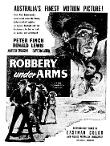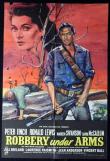AustLit
 6258941096600126078.jpg
6258941096600126078.jpg
Canberra Times, 2 January 1958, p.9
Adaptation of
Robbery Under Arms : A Story of Life and Adventure in the Bush and in the Goldfields of Australia
1882
single work
novel
Issue Details:
First known date:
1957...
1957
Robbery Under Arms
The material on this page is available to AustLit subscribers. If you are a subscriber or are from a subscribing organisation, please log in to gain full access. To explore options for subscribing to this unique teaching, research, and publishing resource for Australian culture and storytelling, please contact us or find out more.
Latest Issues
AbstractHistoryArchive Description
Set in the 1850s, Robbery Under Arms is the story of two brothers, Dick and Jim Marston, who follow their father's footsteps into a life of bushranging through the influence of the charismatic Captain Starlight. The narrative sees the brothers set out on a series of escapades that include theft and robbery under arms. The story also explores the conflicting emotions that Jim experiences as his life leads him further away both from his mother and sister and from the life and love that he might have otherwise have experienced.
Publication Details of Only Known VersionEarliest 2 Known Versions of
Works about this Work
-
Cinematic Visions of Australian Colonial Authority in Captain Thunderbolt (1953), Robbery Under Arms (1957) and Eureka Stockade (1949)
2016
single work
criticism
— Appears in: Studies in Australasian Cinema , vol. 10 no. 2 2016; (p. 237-249) This paper interrogates representations of colonial authority, in particular the police force, in three films with a colonial Australian setting that were produced following the Second World War by British or Australian producers: the local production Captain Thunderbolt (1953) directed by Cecil Holmes; Jack Lee’s British adaptation of Australian literary classic Robbery Under Arms (1957) and Harry Watt’s Eureka Stockade (1949), which was the British production company Ealing Studios’ second production in Australia. I argue that the three films reflect differing approaches to understanding Australian national identity through their representations of authority, ideologically influenced by left-wing politics, the global marketplace and British imperialism. Where Captain Thunderbolt treats the colonial police and government with the sardonic irony and distance of a resistant community, both Eureka Stockade and Robbery Under Arms reinforce and justify Australia’s colonial administration. By detailing the economic, political and social contexts that contributed to these films, I demonstrate how various interest groups appropriated notions of Australian character and history to suit their ideological goals in line with Richard White’s (1992 White, Richard. 1992 arguments in ‘Inventing Australia’. Turning to history and folklore, these interests – including the Australian government, British media conglomerate the Rank Organisation and various left-wing organisations – infused the past they evoked in these films with new meanings that suited their vision of the future.' (Publication summary) -
Representing Australian Space in The Overlanders
2007
single work
criticism
— Appears in: Australia : Making Space Meaningful 2007; (p. 115-123) This paper will examine the influence of Watt's representation of Australian space in The Overlanders on other films made in Australia during the 1950s, including Charles Chauvel's Jedda (1955) and Jack Lee's Robbery Under Arms (1957)...(From author's abstract p. 115) -
y
 He Was a South Australian Film Star : My Life with Billy Pepper
Murray Bridge
:
Nyiri Publications
,
2003
Z1558119
2003
single work
autobiography
He Was a South Australian Film Star : My Life with Billy Pepper
Murray Bridge
:
Nyiri Publications
,
2003
Z1558119
2003
single work
autobiography
-
Killing the Narrator : National Differences in Adaptations of Robbery Under Arms
2002
single work
criticism
— Appears in: JASAL , vol. 1 no. 2002; (p. 44-50) This article focuses on the 1957 cinematic adaptation of Boldrewood's novel. Observing that 'an adaptation to another medium of a previously existing text can be seen as a materialised reading, one determined not only by particular technologies, legal regulations and generic conventions prevailing at the time the adaptation is made, each of which places constraints on what can be represented, but by assumptions about audience expectations and values', Webby examines the extent to which these factors also reflect national differences.
-
Killing the Narrator : National Differences in Adaptations of Robbery Under Arms
2002
single work
criticism
— Appears in: JASAL , vol. 1 no. 2002; (p. 44-50) This article focuses on the 1957 cinematic adaptation of Boldrewood's novel. Observing that 'an adaptation to another medium of a previously existing text can be seen as a materialised reading, one determined not only by particular technologies, legal regulations and generic conventions prevailing at the time the adaptation is made, each of which places constraints on what can be represented, but by assumptions about audience expectations and values', Webby examines the extent to which these factors also reflect national differences. -
y
 He Was a South Australian Film Star : My Life with Billy Pepper
Murray Bridge
:
Nyiri Publications
,
2003
Z1558119
2003
single work
autobiography
He Was a South Australian Film Star : My Life with Billy Pepper
Murray Bridge
:
Nyiri Publications
,
2003
Z1558119
2003
single work
autobiography
-
Representing Australian Space in The Overlanders
2007
single work
criticism
— Appears in: Australia : Making Space Meaningful 2007; (p. 115-123) This paper will examine the influence of Watt's representation of Australian space in The Overlanders on other films made in Australia during the 1950s, including Charles Chauvel's Jedda (1955) and Jack Lee's Robbery Under Arms (1957)...(From author's abstract p. 115) -
Cinematic Visions of Australian Colonial Authority in Captain Thunderbolt (1953), Robbery Under Arms (1957) and Eureka Stockade (1949)
2016
single work
criticism
— Appears in: Studies in Australasian Cinema , vol. 10 no. 2 2016; (p. 237-249) This paper interrogates representations of colonial authority, in particular the police force, in three films with a colonial Australian setting that were produced following the Second World War by British or Australian producers: the local production Captain Thunderbolt (1953) directed by Cecil Holmes; Jack Lee’s British adaptation of Australian literary classic Robbery Under Arms (1957) and Harry Watt’s Eureka Stockade (1949), which was the British production company Ealing Studios’ second production in Australia. I argue that the three films reflect differing approaches to understanding Australian national identity through their representations of authority, ideologically influenced by left-wing politics, the global marketplace and British imperialism. Where Captain Thunderbolt treats the colonial police and government with the sardonic irony and distance of a resistant community, both Eureka Stockade and Robbery Under Arms reinforce and justify Australia’s colonial administration. By detailing the economic, political and social contexts that contributed to these films, I demonstrate how various interest groups appropriated notions of Australian character and history to suit their ideological goals in line with Richard White’s (1992 White, Richard. 1992 arguments in ‘Inventing Australia’. Turning to history and folklore, these interests – including the Australian government, British media conglomerate the Rank Organisation and various left-wing organisations – infused the past they evoked in these films with new meanings that suited their vision of the future.' (Publication summary)
Last amended 24 Sep 2014 15:06:05
Export this record




